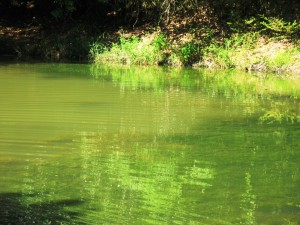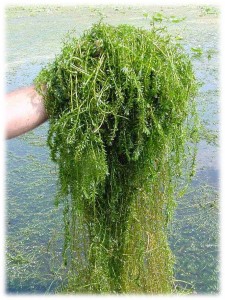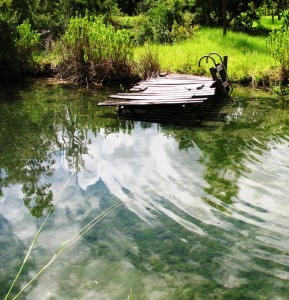North Florida’s cool fall and winter seem a distant memory. Warm temperatures and longer days have kicked pond productivity into “high gear.” Biological activity in and around your pond is in full swing this time of year and there are some “warm weather” management considerations you should be aware of.
Dissolved Oxygen
One of the driving forces influencing water chemistry and biological processes is the amount of dissolved oxygen in the water. Oxygen dissolved in water is absorbed through fish gills to “breath” and is also used by plants (to respire), other aquatic animals, and bacteria. One of the beneficial biological processes influenced by the amount of dissolved oxygen in water is the decomposition of organic waste materials (un-eaten fish food, decaying plant and animal materials, etc.). Because warm water “holds” less dissolved oxygen than cold water, your pond’s dissolved oxygen levels have a greater chance to be lower in the summer than in the winter, especially in the early morning hours before plants begin to photosynthesize and produce oxygen. Longer day lengths and warmer temperatures mean more sunlight and energy for plants to photosynthesize, but the demand for oxygen by other animals and bacteria is also increased. Periods of rainy, overcast days during the summer can greatly reduce oxygen production through plant photosynthesis, and dissolved oxygen levels can drop fast resulting in fish kills. Ponds with excess organic wastes and a high fish density, are at a greater risk of devastating effects of low dissolved oxygen levels. More information about managing oxygen levels in ponds can be found in this publication: Dissolved Oxygen for Fish Production.
Aquatic Plant Management

Without an aerator this productive pond may be at risk of low dissolved oxygen levels and a fish kill.
Summer is the time for lush aquatic plant growth! This growth can sometimes become problematic in farm and fish ponds as it can interfere with fishing access, swimming, or irrigation. There are many types of aquatic plant species including those that are rooted and emergent, like cattails and lilies, those that are rooted and submerged, like eelgrass, or those that float on the water surface, like duckweed. Many of our problematic plants requiring control are non-native species, like hydrilla and waterhyacinth, and millions of dollars are spent each year managing these and other invasive plants on Florida’s public waters. There are some native aquatic plants, like cattails, spike-rush, southern naiad, and duckweed, which, in smaller ponds, can also grow to levels requiring management. As in any pest management endeavor, the first this to do is identify the problem. There is a wealth of information available about aquatic plant management at this website, UF/IFAS Center for Aquatic and Invasive Plants, and at your local County Extension Office.
Management Considerations
-

Hydrilla verticillata. This non-native aquatic plant is one of the world’s worst weeds. Learn more about it to prevent its spread or establishment in your pond!
Even though warmer temperatures have increased fish activity and beneficial bacterial decomposition processes, don’t be tempted to overfeed your fish. Feed them floating fish food so you can see how much they will consume at each feeding. Use the fish’s feeding behavior as your guide. Uneaten food will add excess organic matter to the pond increasing the chances of low oxygen levels and a fish kill. This UF publication has more details on fish feeding: Managing Florida Ponds for Fishing
- If you have an aerator, keep it operative. If you don’t have an aerator, consider purchasing one, especially as your pond ages and fish density increases. It is certainly less costly, in the long run, to be proactive when it comes to maintaining adequate dissolved oxygen in your pond. See this UF Publication for further information: Dissolved Oxygen for Fish Production.
- If you remove dead shoreline plant material from your pond banks, don’t throw the plants, or any other excess organic wastes, into the water. Doing so will increase the amount of organic material that needs to be decomposed, and increase the chance of oxygen depletion.
- If you have aquatic plant problems, now is a great time to contact your County Extension office for identification and control information. Also, scout the pond and pond banks for non-native invasive plant species (your UF Extension Agent can help you identify them). These actions are part of an integrated pest management approach that may include the use of herbicides, mechanical control, and/or grass carp (a plant eating fish).
North Florida’s fish and farm ponds play an important role in many aspects of agricultural and rural life, from irrigation to food production. Maintaining good water quality is critical to the health of these ponds.
Your local County Extension agent has much more information on the above topics. Also, many Extension Agents in the Panhandle have the tools to test your pond’s oxygen level, as well as other water quality indicators. Please contact them if you have any questions.
Sources of additional information and references used for this article:
- Florida Crop/Pest Management Profile: Aquatic Weeds
- Plant Management in Florida Waters
- Managing Florida Ponds for Fishing
- Nitrite in Fish Ponds
- Dissolved Oxygen for Fish Production
- The Role of Aeration in Pond Management
- Maintaining Dissolved Oxygen Levels in Your Pond to Reduce Fish Kills - September 21, 2018
- The Bumble Bee – One of Florida’s Vital Pollinators - September 14, 2018
- 2017-2018 Bee Informed Partnership’s National Bee Colony Loss Report - July 13, 2018

